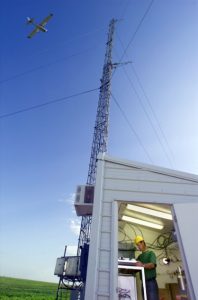Does new NOAA study really show that methane emissions have been overestimated? No.
 By David Lyon and Stefan Schwietzke
By David Lyon and Stefan Schwietzke
A new study published this week in the journal Geophysical Research Letters sheds useful light on some of the technical challenges involved in understanding past trends in methane emissions, but the reporting by industry groups and some media outlets describes conclusions that are at odds with what the researchers themselves actually found.
Led by scientists at the National Oceanic and Atmospheric Administration (NOAA), the paper itself represents a solid analysis. But some of the secondary interpretations of the work have been vastly over-simplified, downplaying or papering over the substantial emissions increases reported by the authors.
What the paper says
The NOAA researchers analyzed 20 datasets measured from aircraft or towers around the U.S. between 2006 and 2015. By comparing how vertical profiles of methane concentration change over time between areas with and without oil and gas sources, they estimate the trends in U.S. total and oil and gas methane emissions.
They conclude that while total U.S. methane emissions—from all sources, including natural—have no significant change, oil and gas emissions have increased 3.4% (± 1.4%) per year, or about 3 million tons more annual emissions in 2015 compared to 2006. Moreover, while sites without oil and gas activities showed no significant change in emissions, locations with oil and gas showed an increase.
Does new NOAA study really show that methane emissions have been overestimated? No. Share on XWe calculate that over the decade in question, the U.S. oil and gas industry emitted over 16 million tons more methane than if its methane emissions had remained at 2006 levels.
This is a huge amount of additional methane waste. In fact, it’s enough natural gas to fuel over 12 million homes for a year. All of which suggests that industry as a whole is not making much progress in reducing emissions, and all the more reason to keep current federal methane rules on the books.
Complex measurements
As has been reported previously, estimating global and regional trends in methane emissions from different sources is very complex. In recent years, many scientific papers using a variety of different methods and assumptions have reported widely divergent estimates of both global and North American oil and gas methane trends. Some of these earlier studies estimate much higher increasing trends in total or oil and gas emissions.
For its part, the NOAA study shows that U.S. oil and gas methane emissions grew at about the same rate as natural gas production, about 40% over the decade in question. That’s a huge amount of methane. Although NOAA finds a smaller overall increase than some earlier research, they still estimate oil and gas emissions have increased about 3.4% per year.
The authors allow that the study “does not address the magnitude of emissions but only focuses on the trend in emissions that can be estimated directly from atmospheric observations.” This top-down trend analysis does highlight limitations of other top-down studies that use ethane and propane to determine trends, because changes in gas composition affects the ratio of these gases to methane. This demonstrates the importance of multiple, independent data sources to help scientists and policymakers understand methane emissions.
What’s the real state of play?
As stated by the authors, the NOAA findings do not address current estimates of methane emissions, such as shown in a sweeping set of oil and gas methane studies organized by EDF. A synthesis of that research published last June in Science found that the U.S. oil and gas industry emits 13 million metric tons of methane from its operations each year—nearly 60% more than had been estimated by the U.S. Environmental Protection Agency.
Bottom line: NOAA’s new paper adds useful insight to a tremendously important conversation—over the last decade there has been a small, increasing trend in oil and gas methane emissions. But by no means does the new paper suggest that the oil and gas industry doesn’t have a very long way to go in reducing these emissions.










